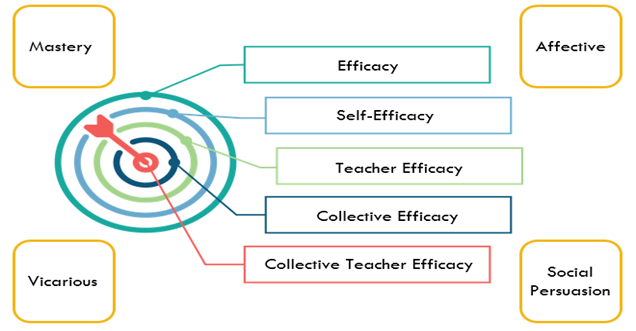UNPACKING COLLECTIVE TEACHER EFFICACY
“Collective Teacher Efficacy is a perception of teachers in a school that the efforts of the faculty as a whole will have a positive effect on students.”
(Goddard et al., 2000)
Educational leaders can transform schools and improve student performance by intentionally building Collective Teacher Efficacy (CTE). Teachers who possess strong efficacy use the types of teaching behaviors that are more likely to positively impact student outcomes (Donohoo, et al, 2018). In contrast, teachers who have low efficacy believe there is little they can do to affect student achievement and are less likely to search for alternative teaching strategies when students are not learning. When teachers have low efficacy, they tend to believe it is students’ lack of ability that causes poor outcomes.
CTE is built when school leaders provide teachers with opportunities to
- build instructional knowledge,
- collaborate with colleagues,
- obtain meaningful feedback, and
- be treated as individuals possessing expertise (Brinson & Steiner, 2007).
Read the brief Building Collective Efficacy (Brinson & Steiner, 2007) which explains how one school moved from a climate of teacher isolation and lack of professional collaboration to a system that experienced the benefits of collective efficacy.
Reflection Questions
- What opportunities were provided to teachers at Tibbott Elementary that enabled collective efficacy to emerge?
- What was the most positive outcome of improved CTE at this school?
As you watch the video clip CTE Training Interview (Raytown Schools, 2018), make a list of evidence that supports high CTE. Which of the elements in your list resonate most with your understanding of CTE and why?
CTE Training Interview (1:44 minutes)
DEVELOPING A COMMON UNDERSTANDING OF EFFICACY
The following graphic organizer illustrates different types of efficacy and how they build toward the bullseye/goal of CTE. Along each corner are four sources or ways efficacy is developed (mastery, affective, vicarious, and social persuasion). A copy of this organizer may be downloaded and used to record definitions as you proceed through this module. Each type of efficacy will be defined in the following section. As you learn more about each type of efficacy, consider how it occurs in your school.

Efficacy
Efficacy is defined as one’s “capacity to produce a desired or intended result” (Dictionay.com, n.d.). Efficacy comes from the same root as the word “effectiveness.” Therefore, a measure of effectiveness can be considered the efficacy. In the context of schools, efficacy can refer to the effects of teaching on student outcomes.
Self-Efficacy
Self-efficacy is an individual’s belief in their own capacity to succeed in specific situations and/or accomplish particular tasks (Bandura, 1986). Self-efficacy reflects one’s confidence, motivation, behavior, and persistence when tasks are difficult. Individuals with low self-efficacy avoid difficult tasks, set less challenging goals, and have a weak commitment to those goals. While individuals with high self-efficacy are confident, set challenging goals, stay committed, and exert enthusiasm in reaching goals. A person with strong self-efficacy has a positive mindset and puts effort toward tackling tasks in order to be successful (Burditt, 2015).
Teacher Efficacy
The term teacher efficacy refers to a teacher’s self-efficacy related to their ability to promote student learning. It is their judgment about their ability to influence student engagement and learning, even for students who may have difficulty learning or are unmotivated. Teachers with a strong sense of self-efficacy tend to exhibit greater levels of planning, organization, and enthusiasm. They are more open to new ideas, more willing to experiment with new methods, and more resilient when they experience difficulty. They tend to be less critical of students who make errors and are more willing to work longer with a student who is struggling (Fisher et al. 2020).
Watch the video Every Kid Needs a Champion (Pierson, 2013). What evidence of teacher efficacy do you hear?
Every Kid Needs a Champion (7:48 min)

